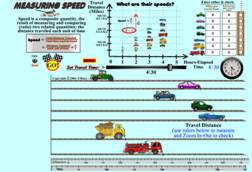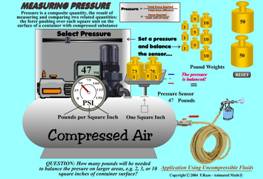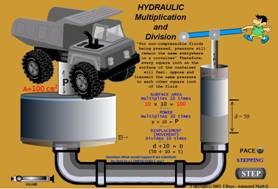 This
display shows measurement of the composite quantity called speed.
Speed is how fast things move, from one place to another.
This
display shows measurement of the composite quantity called speed.
Speed is how fast things move, from one place to another.
|
III - MEASURING PRIMARY AND COMPOSITE QUANTITIES |
|---|
In science, three basic quantities are commonly used to describe primary characteristics of things in the the environment: distance, weight, and time. To describe other things, other useful forms, composite quantities are then created to describe related quantities of objects and actions by compounding and interpreting two or more of the basic quantities. Examples of composite quantities are speed (distance through time), density (weight of volume-distance), temperature (composite description of moving particles over time), electrical energy (composite description of electrical particles and fields moving in space over time), interest rate (composite description of monetary value over time), etc.
To measure basic quantities, standard units such as the meter or foot, kilogram or pound, second, and some convenient monetary unit (e.g. dollar, Euro, Yuan, or Peso) are used. To measure other useful quantities, composite units are used, such as miles-per-hour speed (distance over time), pounds-per-square-inch pressure (weight over space), grams-per-cubic-centimeter density (weight over volume-space), and dollars-per-hour pay rate (monetary value over time).
MEASURING SPEED AND PRESSURE
Call the MEASURING SPEED display.
 This
display shows measurement of the composite quantity called speed.
Speed is how fast things move, from one place to another.
This
display shows measurement of the composite quantity called speed.
Speed is how fast things move, from one place to another.
When an object moves, the distance it goes during each unit of time, is its speed. When traveling at the same speed, the distance traveled by an object during a number of units of time will be a corresponding multiple of its speed. For example: A car moving at 50 miles per hour (speed) for 2 hours, will travel 2 x 50 = 100 miles far.
In the Measuring Speed display, there are seven vehicles, each able to move at a different speed, and for up to 5 hours. If for example, a vehicle moves at a speed of 50 Miles (or kilometers) per (each) Hour (MpH or KpH), and it does so for the 5 hours, the total distance traveled will be 250 miles. Conversely, if a vehicle travels 100 miles in two hours, its speed will be 100/2, or 50 Miles per Hour.
HANDS ON: Wide-screen/Wireless-mouse or Touch-Screen
1.- Use the “Set Travel Time” slider-knob to request a 1 hour run, and push the “GO!” button to start the run.
2.- Use (click and drag) the sliding rulers below to measure the distances (total Kilometers and Miles) traveled by each vehicle, and determine their necessary speed in Miles per Hour (MPH), and Kilometers per Hour (KPH).
|
Vehicle |
Time |
Distance |
Speed in MPH |
Speed
in |
|
|
Miles |
Kilo meters |
||||
|
Green Truck |
1 |
|
|
|
|
|
Pink Geo Car |
1 |
|
|
|
|
|
Blue Pick-up |
1 |
|
|
|
|
|
Small Green SUV |
1 |
|
|
|
|
|
Blue Mustang |
1 |
|
|
|
|
|
Yellow dump truck |
1 |
|
|
|
|
|
Red fire truck |
1 |
|
|
|
|
4.- Adjust the Set Travel Time slider knob sequentially to repeat steps 2 and 3 above to run the vehicles though different run time hours. When each run is completed, measure the distances and - Use the on-display calculator keypad provided to enter the distance in miles or kilometers measured, have the calculator compute directly the speed (average distance traveled for every unit of time traveled) with the "GET SPEED" key. The resulting number can be transfered directly to the corresponding cell of the on-screen table provided (top right section of the display). Both English (MPH) and Metric (KPH) speeds can then be checked for correctness (by clicking into their adjoining check-box).
|
Vehicle |
1 Hour |
2 Hours |
3 Hours |
4 Hours |
5 Hours |
|
Green Truck |
/ |
/ |
/ |
/ |
/ |
|
Pink Geo Car |
/ |
/ |
/ |
/ |
/ |
|
Blue Pick-up |
/ |
/ |
/ |
/ |
/ |
|
Small Green SUV |
/ |
/ |
/ |
/ |
/ |
|
Blue Mustang |
/ |
/ |
/ |
/ |
/ |
|
Yellow dump truck |
/ |
/ |
/ |
/ |
/ |
|
Red fire truck |
/ |
/ |
/ |
/ |
/ |
4.- How far will each of the vehicles go in one-half hour?
|
Vehicle |
1/2 Hour |
|
Green Truck |
/ |
|
Pink Geo Car |
/ |
|
Blue Pick-up |
/ |
|
Small Green SUV |
/ |
|
Blue Mustang |
/ |
|
Yellow dump truck |
/ |
|
Red fire truck |
/ |
Call the MEASURING PRESSURE display.
 This
display illustrates the use of the composite quantity pressure,
used to describe the intensity of forces
pushing and being resisted by
objects
in contact while being held in
containers.
This
display illustrates the use of the composite quantity pressure,
used to describe the intensity of forces
pushing and being resisted by
objects
in contact while being held in
containers.
When
pressure is applied, objects naturally resist it, by not yielding,
and an unwillingness to reduce the content space they occupy. When
objects resist successfully, and retain their content space, i.e.
volume, they are called non-compressible.
Objects that are not successful at resisting pressures, allowing for
their volume to be compressed and reduced, are called compressible.
The special (hydraulic) fluid used to put pressure on the brakes of
an automobile, or in some industrial presses, for example, are highly
non-compressible fluids. The fluid used in automotive tires
(e.g. air, nitrogen), cushions, beach balls, pressure spraying
systems (e.g. air), and utility burn gases (e.g. propane), are very
compressible.
When a fluid is forced into a container, the pressure exerted over any part of it is distributed and dispersed evenly over all other parts of its surface in touch with the container. This is called the Pascal Principle (Blaise Pascal, 1623).
In the Measure Pressure display, a storage tank is being filled with compressed air, and the pressure for compression is provided by an air compressor on top of the tank. Because the air is a fluid, the pressure being exerted over each square inch of the compressor motor piston, the surface of tank, the attached hose, or the spout is the same.
The display will allow changing the pressure in the tank (measured in “Pounds per Square Inch, or PSI), using the horizontal lever control on the compressor, and testing the pressure on the surface of the container, by balancing out the force with corresponding weights applied on a tray over a one-square-inch unit surface of the tank.
HANDS ON: Wide-screen/Wireless-mouse or Touch-Screen
1.- Use the slider at the top of the tank to adjust the PRESURE on the air compressor, to the various pressure levels in PSI (Pounds per Square Inch) given below, and think of a combination of Pound weights that would neutralize (balance) the pressure, when placed over the weight-tray sitting over the 1 Square Inch on tank surface at the top.
|
Pressure (PSI) |
Pound Weights NEEDED |
|
0 |
|
|
10 |
|
|
20 |
|
|
25 |
|
|
40 |
|
|
78 |
|
|
100 |
|
|
128 |
|
|
150 |
|
2.- Ask the class: What would happen if we used a non-compressible fluid in the tank of the display?
Call the HYDRAULIC Multiplication and Division display
 This
display shows how pressure forces can be amplified by the use of
rigid, connected pistons and tubes, filled with a non-compressible
fluid.
This
display shows how pressure forces can be amplified by the use of
rigid, connected pistons and tubes, filled with a non-compressible
fluid.
When forces are applied over small surface areas, such as thin pistons, these are transmitted all over the system by the non-compressible fluid, and eventually collected in multiples over larger surfaces (large pistons) to perform heavier duty tasks. These arrangements are called “hydraulic” systems.
In the display, the hard work of the person pushing on the narrow piston is multiplied by the powerful push over the multiple-times larger area of the larger piston, much as it occurs in a typical hydraulic car jack. In other words, smaller forces, pushing over smaller areas of non-compressible fluids are being used to produce smaller displacement of larger areas of the fluid, to produce a multiplying effect on forces.
1.- Write an answer to the question: What makes the little person of the animation so "powerful"?
Currently, much of the industrial infrastructure has come to rely on the ability of hydraulic power systems to multiply forces, move and control physical components powerfully in all kinds of manufacturing, transportation, and household equipment. The typical automobile today, for example, uses hydraulic power in its transmission, steering, air conditioning, breaking, windshield cleaning systems and in powering car-lifting jacks for tire replacement. Compressible fluid systems are used in filling up a car’s tires to pressures that are useful and safe for operating vehicles at necessary speeds and carrying loads.
Common units of measure for pressure are:
Newton per Square Meter (Pascal),
Pounds per Square Inch (PSI)
Atmospheres (pressure exerted by the air on every square centimeter of surface at sea level)
Millimeters of Mercury (atmospheric pressure measured by a barometer - the height of a column of the liquid metal Mercury)
HANDS ON: Wide-screen/Wireless-mouse or Touch-Screen
1.- Complete the following table: If the PSI in a (rigid) tank is 25 PSI, what would be the force exerted over pistons of the following pressure area, connected to the system?
|
Area in Square Inches (SI) |
TOTAL Pound Weights NEEDED |
|
1 |
|
|
2 |
|
|
10 |
|
|
100 |
|
2.- Complete the following table: If the PSI in a (rigid) tank is 50 PSI, what would be the force exerted over pistons of the following pressure area, connected to the system?
|
Area in Square Inches (SI) |
TOTAL Pound Weights NEEDED |
|
1 |
|
|
2 |
|
|
10 |
|
3.- Ask the class: Investigate (Internet or other sources) what are the typical pressure measures for the practical applications listed in the table below, and the problems that can happen if the pressures are lower, or higher than normal.
|
Application |
Typical PSI |
Problem if OVER or UNDER pressure |
|
Car tires filled with air or nitrogen |
|
|
|
Bicycle tires filled with air |
|
|
|
Home water pressure |
|
|
|
Swimming pool filter pump |
|
|
|
Shark byte force |
|
|
|
Truck brakes fluid |
|
|
|
Human blood pressure |
|
|
NOTE: For humans, a quantity called systolic blood pressure (PSI) is used: Blood pressure monitors are normally scaled in millimeters of mercury, and 1mm of mercury is the same as (=) 0.019337 PSI. Healthy LOW (Diastolic) and HIGH (Systolic) blood pressure in humans is between 80 "mm of mercury"(1.55 PSI) and 120 mm of mercury (2.32 PSI).
|
|
|---|